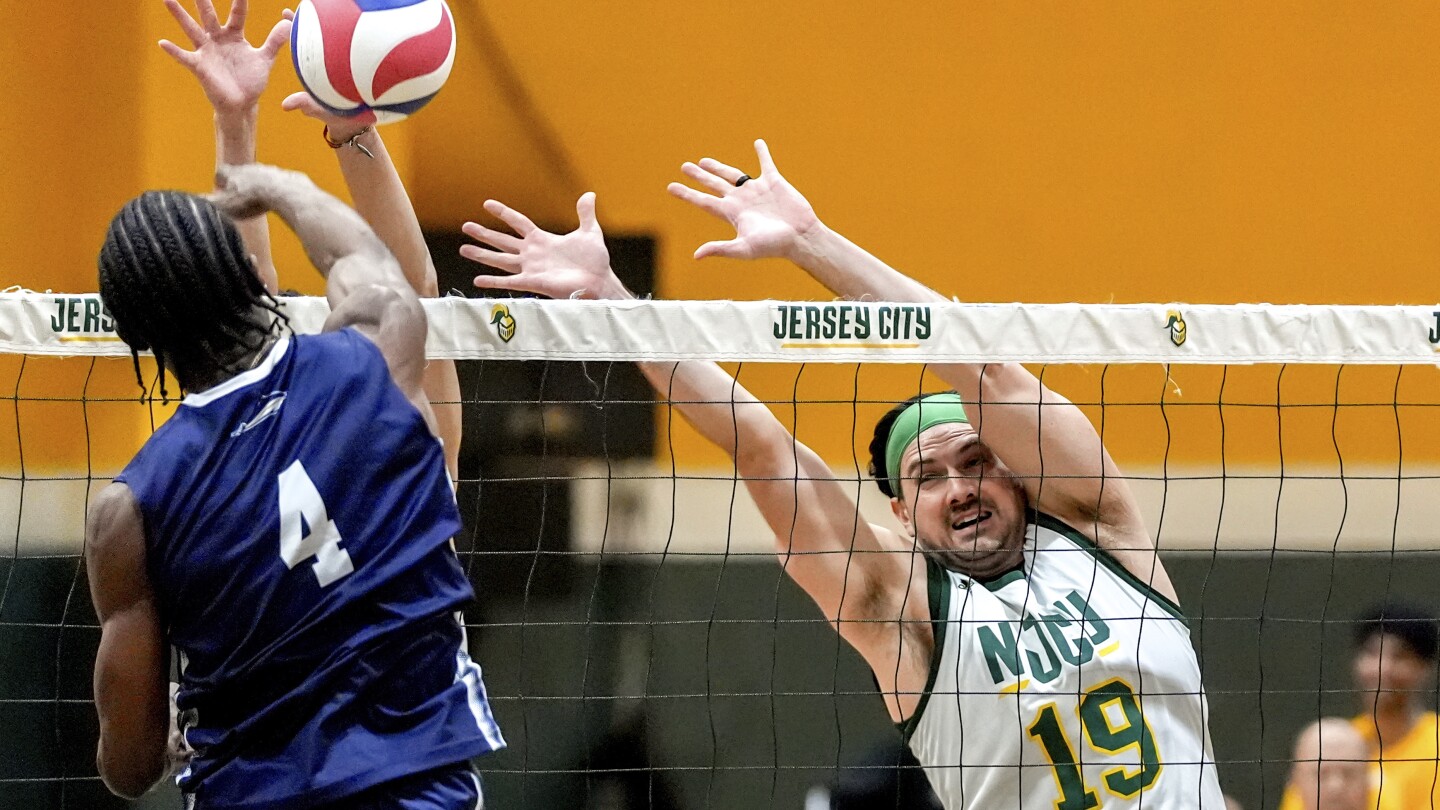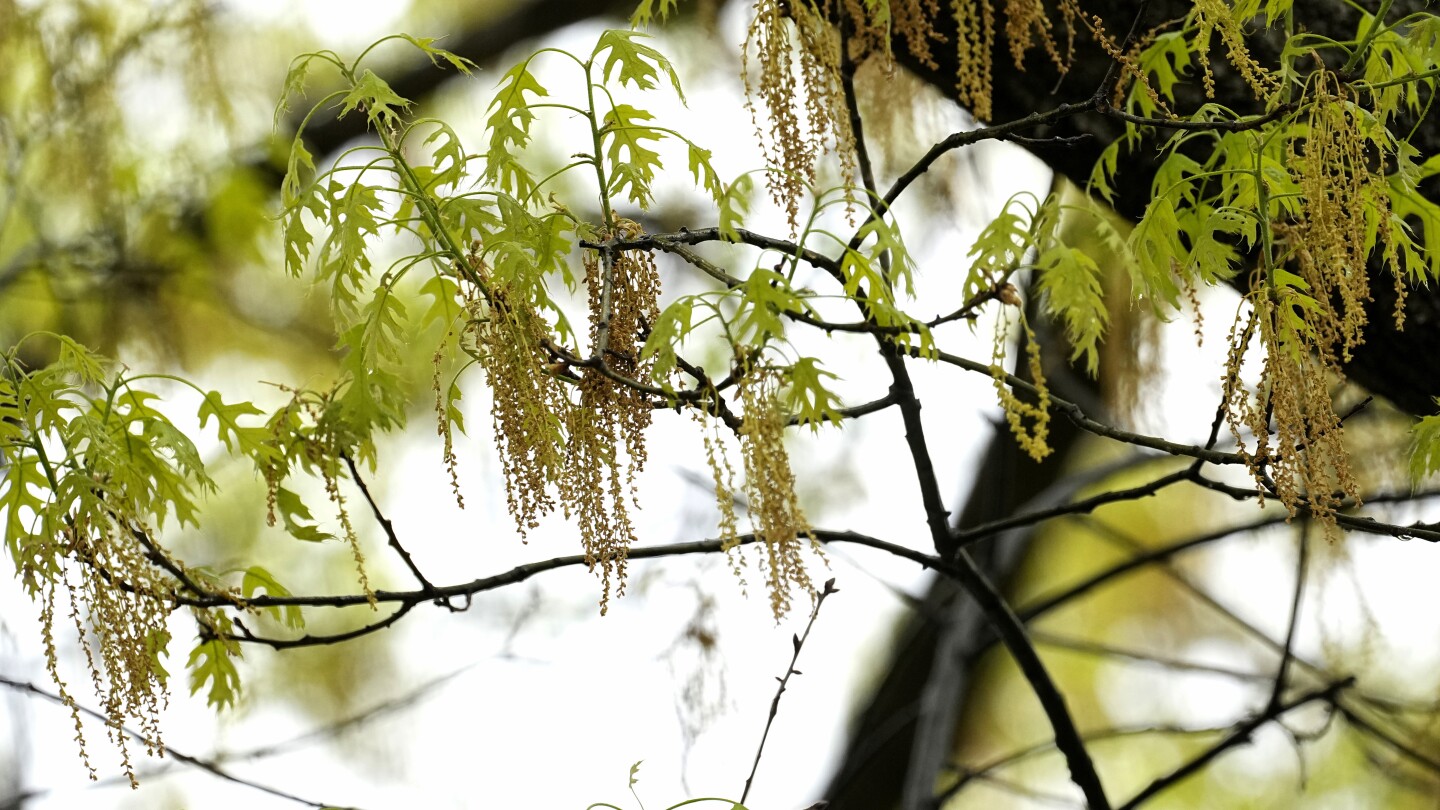Lifestyle
Aches, pains and joy for 40-year-old man savoring his second chance to play college volleyball

Damon LaSalle keeps the athletic trainers busy at New Jersey City University.
As he gets out of bed, his hamstrings, knees and back give him daily reminders that playing college volleyball can take a toll on the body. He has standing appointments with a chiropractor and acupuncturist in addition to the frequent visits to the training room.
“I have like a professional team taping me and sewing me together,” he said, laughing.
Those aches and pains are magnified for LaSalle.
He is, after all, 40 years old.
LaSalle plays middle blocker for the Knights, and most of his teammates weren’t born 20 years ago when he was one of the biggest stars in Division III. His first go in college ended because he was ruled academically ineligible before what would have been his senior season.
With his wife’s encouragement, the stay-at-home dad went back to school so he could honor his late mother’s wish that he earn a degree and to set an example for his three children. He also wanted to put a proper bow on his volleyball career.
The academic part has been no problem. LaSalle is a fire science major who is on the dean’s list with a 3.8 grade-point average on a 4.0 scale, and he is on track to graduate this spring.
The volleyball part has been an adventure. He has been limited to 10 of the Knights’ first 18 matches because of his assortment of injuries. Not all were volleyball-related. He missed two matches with a classic dad injury — he tweaked his hamstring shoveling snow and the pain migrated to his back.
40 going on 20
LaSalle doesn’t jump as high or move as quickly as he once did. The way he describes it, he once could dunk a basketball and now can grab the rim with both hands. The guy can still play a little volleyball, though.
Knights coach Carlo Edra, who played with LaSalle at NJCU from 2004-06, said he’s shown two opposing coaches a photo array of the team and asked them to identify the 40-year-old. Both pointed to someone other than LaSalle.
LaSalle can keep up with his younger teammates, but he’s not the intimidating middle he once was. In 2006, he was national player of the week once and division player of the year in the old North East Collegiate Volleyball Association, which was Division III’s top league. He is NJCU’s career leader in block assists, and in wrapping his fourth season he is on the cusp of becoming the program’s all-time leader in total blocks.
“His resume was right on hall of fame level at this college,” said Ira Thor, the school’s former sports information director.
A sudden ending
LaSalle’s first stint at NJCU ended suddenly. He was in preseason training during the fall of 2006 when an assistant athletic director pulled him out of practice and told him he was ineligible. His grade-point average was 1.4, the equivalent of a D-plus.
“I was more of an athlete-student instead of a student-athlete,” he said. “That happens to a lot of kids, and I let it get too far. I got to a point where when the athlete part wasn’t available to me, it wasn’t as interesting to be a student.”
So he quit school and, needing a job, asked Edra for help. Edra had graduated the year before and worked at a kitchen cabinet company. Edra recommended LaSalle, and he spent six or seven years there and became warehouse manager. LaSalle ended up marrying the woman who interviewed him for the job, and when Christina and he began a family, he was able to stay home.
The LaSalles live about a 35-minute drive from NJCU’s Jersey City campus and have daughters ages 4 and 6 and a son who’s 8.
When he asked Christina if she would be OK with him going to school and playing volleyball again, she told him it would make her proud if he did.
“That gave me goosebumps,” he said. “It made me feel like I could really do this.”
His biggest regret
LaSalle said his biggest regret was dropping out of school, and his desire to go back grew stronger several years ago when he came across his wife’s diploma from Rutgers.
“I looked at it and I was, ‘I want one of these,’” he said. “Carlo and I had a conversation, What if my kids ask me why I don’t have one, what would my answer be to them about why I didn’t finish?”
LaSalle, Edra and their former teammates have remained close over the years, and during their get-togethers or in their group texts somebody occasionally would suggest LaSalle finish what he started academically and athletically.
In Division III, an athlete gets 10 semesters as a full-time student to play four seasons. There is no running eligibility clock as in Division I, so an athlete could leave school and return in, say, 20 years and pick up where he left off.
In LaSalle’s case, he had played three seasons over seven semesters. To get his grades up and preserve his one remaining season of eligibility, LaSalle could only enroll as a part-time student and take a couple classes per semester.
The slog to eligibility ended last summer. He became a full-time student in the fall and joined the team.
‘Coming off the scrap heap’
The only volleyball LaSalle had played since 2006 was with Edra in a summer sand volleyball league at a bar.
“I’m not coming off the club court or anything,” LaSalle said. “I was coming off the scrap heap, as they say, off the couch.”
Actually, LaSalle had stayed fit over the years and that picked up once he decided to pursue college volleyball again. LaSalle knew he would have to earn his playing time and that Edra wouldn’t give him special treatment because of their two-decade friendship.
“So if one of your kids is throwing a temper tantrum and you’re late to practice, I’ve got to make you run, dude,” Edra said he told LaSalle.
Sure enough, LaSalle stopped for coffee on his way to practice one day, had trouble finding a parking spot on campus and showed up late. He had to run laps, do 100 squat lifts, 30 pushups, a three-minute wall sit (a grueling quadriceps exercise) and a three-minute plank.
“There’s been plenty of days when I get home from these practices and I’ll tell my wife, ‘Should I be doing this? Am I going to be OK tomorrow?’” LaSalle said. “Every day I wake up and here I am.”
Embraced by teammates
His teammates have embraced him, first calling him “Unc,” as in uncle. The nickname morphed to “Big 40” and stuck. Alex Casais, the team captain, said he treated LaSalle like any other teammate when practice started.
“I was not giving him the props,” he said. “I couldn’t. I had to make sure to he was earning it on the court. He hit one ball and I knew it was over. I knew we were good.”
LaSalle said his approach was to blend in with his new teammates. That meant being quiet and doing what everybody else was doing. He said he never expected his teammates to know what he had accomplished 20 years ago, calling it immaterial.
“He came in with a sense of dignity,” Casais said. “He stepped on the court, and his head was down and he was going to work. I felt like a lot of the younger guys looked up to him, and that’s where ‘Big 40’ came from. He was someone working as hard as everyone else, if not harder.”
Savoring every moment
LaSalle said the game has become faster, players jump higher, systems are more sophisticated and the disparity between the top and bottom teams is smaller.
But if anyone thought LaSalle would embarrass himself, he proved them wrong.
“It was kind of a surprise to everybody that once we all got in the gym in the fall season that he started to compete for the starting spot,” Edra said. “The fact he’s keeping up with guys that are 21 years old and 20, 18 — it’s kind of crazy.”
For LaSalle, it’s crazy fun. He said he savors every moment because he realizes he got an almost unimaginable second chance. Recalling 2006, he said, “I played my last game, and I didn’t know it was my last game.”
And now?
“Every practice we finish, it’s one less practice that I have before it’s over,” he said. “So I don’t take that for granted. I don’t take any day for granted at all.”
___
AP college sports: https://apnews.com/hub/college-sports
Lifestyle
Allergy season: How to check pollen levels and alleviate symptoms

ATLANTA (AP) — Allergy season can be miserable for tens of millions of Americans when trees, grass, and other pollens cause runny noses, itchy eyes, coughing and sneezing.
Where you live, what you’re allergic to and your lifestyle can make a big difference when it comes to the severity of your allergies. Experts say climate change is leading to longer and more intense allergy seasons, but also point out that treatments for seasonal allergies have become more effective over the last decade.
Here are some tips from experts to keep allergy symptoms at bay — maybe even enough to allow you to enjoy the outdoors.
Where are pollen levels the worst this year?
The Asthma and Allergy Foundation of America issues an annual ranking of the most challenging cities to live in if you have allergies, based on over-the-counter medicine use, pollen counts and the number of available allergy specialists.
This year, the top five cities are: Wichita, Kansas; New Orleans; Oklahoma City; Tulsa, Oklahoma; and Memphis.
Which pollens cause allergies?
There are three main types of pollen. Earlier in the spring, tree pollen is the main culprit. After that grasses pollinate, followed by weeds in the late summer and early fall.
Some of the most common tree pollens that cause allergies include birch, cedar, cottonwood, maple, elm, oak and walnut, according to the Asthma and Allergy Foundation of America. Grasses that cause symptoms include Bermuda, Johnson, rye and Kentucky bluegrass.
This article is part of AP’s Be Well coverage, focusing on wellness, fitness, diet and mental health. Read more Be Well.
How do I track pollen levels?
Pollen trackers can help you decide when to go outside. The American Academy of Allergy Asthma and Immunology tracks levels through a network of counting stations across the U.S. Counts are available at its website and via email.
Limit your exposure to pollens
The best and first step to controlling allergies is avoiding exposure. Keep the windows in your car and your home closed, even when it’s nice outside.
If you go outside, wearing long sleeves can keep pollen off your skin to help ward off allergic reactions, said Dr. James Baker, an allergist at the University of Michigan. It also provides some sun protection, he added.
When you get home, change your clothes and shower daily to ensure all the pollen is off of you — including your hair. If you can’t wash your hair every day, try covering it when you go outside with a hat or scarf. Don’t get in the bed with your outside clothes on, because the pollen will follow.
It’s also useful to rinse your eyes and nose with saline to remove any pollen, experts said. And the same masks that got us through the pandemic can protect you from allergies — though they won’t help with eye symptoms.
How to relieve allergy symptoms
Over-the-counter nasal sprays are among the most effective treatments for seasonal allergies, experts said.
But the vast majority of patients use them incorrectly, irritating parts of the nose, said Dr. Kathleen Mays, an allergist at Augusta University in Georgia. She suggested angling the nozzle outward toward your ear rather than sticking it straight up your nose.
Over-the-counter allergy pills like Claritin, Allegra and Zyrtec are helpful, but may not be as effective as quickly since they’re taken by mouth, experts said.
Experts also said that if your allergy symptoms are impacting your quality of life, like causing you to lose sleep or a lack focus at work or school, it might be time to consider an allergist appointment for immunotherapies.
Some remedies for allergy relief that have been circulating on social media or suggested by celebrities — like incorporating local honey into your diet to expose yourself to pollen — have been debunked.
Dr. Shayam Joshi, an allergist at Oregon Health and Science University, said that’s because the flowers that bees pollinate typically don’t contain the airborne pollen that causes allergy symptoms.
Is allergy season changing?
With climate change, winters are milder and growing seasons are longer, meaning there’s more opportunity for pollen to stay in the air, resulting in longer and more severe allergy seasons.
In many areas across the country, pollen counts have broken decades of records. In late March, the Atlanta Allergy and Asthma Center measured a pollen count of over 14,000 grains per cubic meter, which is considered extremely high.
___
The Associated Press Health and Science Department receives support from the Howard Hughes Medical Institute’s Science and Educational Media Group and the Robert Wood Johnson Foundation. The AP is solely responsible for all content.
Lifestyle
The 250th anniversary of the Battles of Lexington and Concord opens debate over US independence
NEW YORK (AP) — The American Revolution began 250 years ago, in a blast of gunshot and a trail of colonial spin.
Starting with Saturday’s anniversary of the Battles of Lexington and Concord, the country will look back to its war of independence and ask where its legacy stands today.
The semiquincentennial comes as President Donald Trump, the scholarly community and others divide over whether to have a yearlong party leading up to July 4, 2026, as Trump has called for, or to balance any celebrations with questions about women, the enslaved and Indigenous people and what their stories reveal.
The history of Lexington and Concord in Massachusetts is half-known, the myth deeply rooted.
What exactly happened at Lexington and Concord?
Reenactors may with confidence tell us that hundreds of British troops marched from Boston in the early morning of April 19, 1775, and gathered about 14 miles (22.5 kilometers) northwest on Lexington’s town green.
Firsthand witnesses remembered some British officers yelled, “Thrown down your arms, ye villains, ye rebels!” and that amid the chaos a shot was heard, followed by “scattered fire” from the British. The battle turned so fierce that the area reeked of burning powder. By day’s end, the fighting had continued around 7 miles (11 kilometers) west to Concord and some 250 British and 95 colonists were killed or wounded.
But no one has learned who fired first, or why. And the revolution itself was initially less a revolution than a demand for better terms.
Woody Holton, a professor of early American history at the University of South Carolina, says most scholars agree the rebels of April 1775 weren’t looking to leave the empire, but to repair their relationship with King George III and go back to the days preceding the Stamp Act, the Tea Act and other disputes of the previous decade.
“The colonists only wanted to turn back the clock to 1763,” he said.
Stacy Schiff, a Pulitzer Prize winning historian whose books include biographies of Benjamin Franklin and Samuel Adams, said Lexington and Concord “galvanized opinion precisely as the Massachusetts men hoped it would, though still it would be a long road to a vote for independence, which Adams felt should have been declared on 20 April 1775.”
But at the time, Schiff added, “It did not seem possible that a mother country and her colony had actually come to blows.”
A fight for the ages
The rebels had already believed their cause greater than a disagreement between subjects and rulers. Well before the turning points of 1776, before the Declaration of Independence or Thomas Paine’s boast that “We have it in our power to begin the world over again,” they cast themselves in a drama for the ages.
The so-called Suffolk Resolves of 1774, drafted by civic leaders of Suffolk County, Massachusetts, prayed for a life “unfettered by power, unclogged with shackles,” a fight that would determine the “fate of this new world, and of unborn millions.”
The revolution was an ongoing story of surprise and improvisation. Military historian Rick Atkinson, whose “The Fate of the Day” is the second of a planned trilogy on the war, called Lexington and Concord “a clear win for the home team,” if only because the British hadn’t expected such impassioned resistance from the colony’s militia.
The British, ever underestimating those whom King George regarded as a “deluded and unhappy multitude,” would be knocked back again when the rebels promptly framed and transmitted a narrative blaming the royal forces.
“Once shots were fired in Lexington, Samuel Adams and Joseph Warren did all in their power to collect statements from witnesses and to circulate them quickly; it was essential that the colonies, and the world, understand who had fired first,” Schiff said. “Adams was convinced that the Lexington skirmish would be ‘famed in the history of this country.’ He knocked himself out to make clear who the aggressors had been.”
A country still in progress
Neither side imagined a war lasting eight years, or had confidence in what kind of country would be born out of it. The founders united in their quest for self-government but differed how to actually govern, and whether self-government could even last.
Americans have never stopped debating the balance of powers, the rules of enfranchisement or how widely to apply the exhortation, “All men are created equal.”
“I think it’s important to remember that the language of the founders was aspirational. The idea that it was self-evident all men were created equal was preposterous at a time when hundreds of thousands were enslaved,” said Atkinson, who cites the 20th-century poet Archibald MacLeish’s contention that “democracy is never a thing done.”
“I don’t think the founders had any sense of a country that some day would have 330 million people,” Atkinson said. “Our country is an unfinished project and likely always will be.”
Lifestyle
Sweets from the sky! A helicopter marshmallow drop thrills kids in suburban Detroit

ROYAL OAK, Mich. (AP) — It’s spring in Detroit — warm weather, a few clouds, and a 100% chance of marshmallow downpours.
The source? A helicopter zooming above the green lawn of Worden Park on Friday, unloading sack-fulls of fluffy treats for hundreds of kids waiting eagerly below, some clutching colorful baskets or wearing rabbit ears.
The children cheered and pointed as the helicopter clattered by on its way to the drop zone. Volunteers in yellow vests made sure kids didn’t rush in and start grabbing marshmallows until after the deluge was complete.
For anyone worried about hygiene, don’t fret. The annual Great Marshmallow Drop isn’t about eating the marshmallows — kids could exchange them for a prize bag that included a water park pass and a kite.
The marshmallow drop has been held for over three decades in the Detroit suburb of Royal Oak, Michigan, hosted by Oakland County Parks.
One toddler, Georgia Mason, had no difficulty procuring a marshmallow at her first drop, her dad Matt said.
“Probably the most exciting part was seeing the helicopters. But once we saw the marshmallows drop, we got really excited,” Matt Mason said.
“And, yeah, we joined the melee,” he said, “We managed to get one pretty easy.”
Organizers said 15,000 marshmallows were dropped in all.
The helicopter made four passes, dropping marshmallows for kids in three age categories: 4-year-olds and younger, 5-7-year-olds, and those ages 8 to 12. A drop for kids of all ages with disabilities came later in the day.
“We do it because it’s great for community engagement,” Oakland County recreation program supervisor Melissa Nawrocki said.
“The kids love it,” she continued. “The looks on their faces as they’re picking up their marshmallow and turning in the marshmallow for prizes is great.”
-

 Education1 day ago
Education1 day agoHarvard’s battle with the Trump administration is creating a thorny financial situation
-

 Lifestyle1 day ago
Lifestyle1 day agoSweets from the sky! A helicopter marshmallow drop thrills kids in suburban Detroit
-

 Sports1 day ago
Sports1 day agoAaron Rodgers ‘not holding anybody hostage’ as he decides his future, retirement a possibility
-

 Conflict Zones1 day ago
Conflict Zones1 day agoTrump says US may ‘pass’ on helping end war if Russia, Ukraine resist deal | Russia-Ukraine war News
-

 Sports2 days ago
Sports2 days agoNY Rangers’ Panarin, MSG reportedly made settlement payments after employee made sexual assault allegations
-

 Europe2 days ago
Europe2 days agoLive updates: Trump news, Ukraine peace talks, US immigration, tariffs and university funding
-

 Lifestyle1 day ago
Lifestyle1 day agoFans of Superman relate to comic’s religious and ethical themes
-

 Europe1 day ago
Europe1 day agoTrump’s ‘lone ranger’: How Steve Witkoff became the defacto point man on America’s foreign policy challenges



